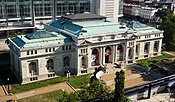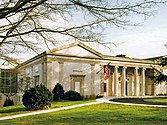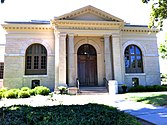Albert Randolph Ross

Albert Randolph Ross (October 26, 1868 – October 27, 1948) was an American architect. Born in Westfield, Massachusetts, he was a son of architect John W. Ross.
Albert Ross attended grammar school in Westfield and later in Davenport, Iowa, where he went on to high school, finishing in 1884.[1] After working as a draughtsman in his father's Davenport architecture office from 1884 to 1887, he spent a year working for an architect in Buffalo, New York, before joining the New York City firm of McKim, Mead and White in 1891.[1][2] In 1898, he formed the firm of Ackerman & Ross with William S. Ackerman, a partnership which dissolved in 1901.[2]
In 1927, when he was awarded a $10,000 prize in a competition to design a new courthouse for Milwaukee out of 33 who submitted proposals,[3] he told the Milwaukee Journal why he settled on a traditional design:[4]
When I went into the competition I considered whether to design a building in the modern and experimental trend for a great public courthouse. I made modern sketches, but in my opinion they fell flat for this purpose. They were not typical and expressive of public work, so I turned to that type established by our forefathers.... I have no quarrel with trends in modern architecture. I take a fling at it myself. But it simply won't do for public buildings. It violates the dictates of a definite style built up through one hundred and fifty years of our history. A departure into modernism would not be suitable for a courthouse. We must be trained slowly to things violently new. The public's money cannot rightly be used to force experiments down its throat.
In 1901, Ross married Susan Husted, from Brookline, Massachusetts.[1] From 1901 until 1948 his main residence was on Negro Island, near Boothbay Harbor, Maine.[2] He died October 27, 1948.[2]
Principal architectural works[]
Among the buildings that Ross designed were 12 libraries.[2] Some of his notable design projects included:
- Carnegie Library, Washington, DC,[1] also known as Central Public Library, now the Historical Society of Washington, D.C.[5] Mount Vernon Square Washington, DC, an NRHP-listed work of Ackerman & Ross (1902).
- Carnegie Library, Atlanta, Georgia, by Ackerman & Ross (1902).
- Carnegie Laboratory of Engineering, Stevens Institute, Hoboken, New Jersey, by Ackerman & Ross (1902).[6]
- Carnegie Library, San Diego, California, by Ackerman & Ross (1903; demolished 1952).
- Port Jervis Free Library, Port Jervis, New York, by Ackerman & Ross (1903).
- Carnegie Library, Atlantic City, New Jersey (1903).
- Taunton Public Library, Taunton, Massachusetts (1903).
- East Orange Public Library, East Orange, New Jersey, now the East Orange Municipal Court Building (1903).[5]
- Nashville Main Library, Nashville, Tennessee (1904).
- Needham Public Library, Needham, Massachusetts (built 1904; demolished)
- Needham Free Public Library, Needham, Massachusetts (1904).[7]
- Old Town Public Library, Old Town, Maine (1904).[8]
- Gloversville Free Library, Gloversville, New York, Beaux Arts building listed on the National Register of Historic Places (1904).[9]
- Pittsfield Public Library, Pittsfield, Maine; NRHP-listed for its architecture (1904).[9]
- Union County Courthouse, Elizabeth, New Jersey as Ackerman & Ross (1905)."[10]
- Public Library, Penn Yan, New York, (dedicated June 22, 1905).[11]
- Cragin Memorial Library, Colchester, Connecticut (dedicated July 5, 1905).[12]
- Uinta County Library, Evanston, Wyoming, now the Uinta County Museum (completed 1906).
- Pennsylvania Memorial, Vicksburg National Military Park, with Charles Albert Lopez, sculptor (dedicated March 24, 1906).
- Original portion of the Main Library of the Columbus Metropolitan Library system, Columbus, Ohio (dedicated April 4, 1907).[1][2]
- Carnegie Library, Good Will Home Association, Hinckley, Maine (dedicated May 29, 1907).
- McKinley Memorial, Philadelphia, Pennsylvania, with and Isidore Konti, sculptors (dedicated June 6, 1908).
- Exterior design for Draper Hall, State University at Albany, Albany, New York (1909).[13]
- Union Soldiers and Sailors Monument, Baltimore, designed by Ross with sculpture by Adolph Alexander Weinman (1909).
- Carnegie Library, Denver, Colorado; now the McNichols Civic Center Building (1910).[1][14]
- Montclair Art Museum, Montclair, New Jersey (1914).
- Milwaukee County Courthouse, Milwaukee, Wisconsin (1931).[2]
Gallery[]

The Central Public Library (now the Historical Society of Washington, D.C.), completed 1902 by Ackerman & Ross.

Taunton Public Library, Taunton, Massachusetts, completed 1903.

Carnegie Library, Atlantic City, New Jersey, completed in 1903.

Carnegie Library, Old Town, Maine, completed 1904.

Gloversville Free Library, Gloversville, New York, completed in 1904.
Cragin Memorial Library, Colchester, Connecticut, dedicated July 5, 1905.

Public Library, Pittsfield, Maine, completed in 1906.

Uinta County Library, Evanston, Wyoming, completed in 1906.

Carnegie Library, Columbus, Ohio, completed in 1907.

Good Will-Hinckley Library, Hinckley, Maine, dedicated in 1907.

Union Soldiers and Sailors Monument in Baltimore, designed by Ross with sculpture by Adolph Alexander Weinman, dedicated in 1909.

Denver Public Library, Denver, Colorado, completed in 1910.

Montclair Art Museum, Montclair, New Jersey, completed in 1914.

Milwaukee County Courthouse, Milwaukee, Wisconsin, completed in 1931.
References[]
- ^ Jump up to: a b c d e f John William Leonard, Albert Nelson Marquis. Who's who in America, Volume 4: Albert Randolph Ross.
- ^ Jump up to: a b c d e f g "Columbus in Photographs: Albert Randolph Ross". Archived from the original on 2011-09-27. Retrieved 2011-05-05.
- ^ "Architect Here Wins $10,000 Prize" (PDF). New York Times. August 4, 1927. Retrieved February 11, 2015.
- ^ Wright, Frank Lloyd (1943). Frank Lloyd Wright: An Autobiography. Duell ,Sloan and Pearce. p. 358.
- ^ Jump up to: a b "Library History". Port Jervis Free Public Library. Archived from the original on 2011-09-14. Retrieved 2011-10-04.
- ^ Evening Times-Republican, March 4, 1902, page 5.
- ^ Needham Free Public Library, accessed February 11, 2015
- ^ Old Town Public Library, accessed February 11, 2015
- ^ Jump up to: a b "National Register Information System". National Register of Historic Places. National Park Service. March 13, 2009.
- ^ The Courier-News (Bridgewater, New Jersey), May 4, 1905, page 2: "The work of engraving two tablets...at the new courthouse is in progress. The tablet on the right will read 'Union County Courthouse Commenced February 1903; Completed April 1905...Architects, Ackerman & Ross..."
- ^ Democrat and Chronicle (Rochester, New York), June 24, 1905, page 3.
- ^ Hartford Courant (Hartford, Connecticut), July 6, 1905, page 10.
- ^ Draper Hall, M.E. Grenander Department of Special Collections and Archives, University Libraries, University at Albany
- ^ Former Carnegie Library, Denver
- 19th-century American architects
- 1868 births
- 1948 deaths
- Architects from New York City
- Architects from Maine
- People from Lincoln County, Maine
- 20th-century American architects
- People from Westfield, Massachusetts














